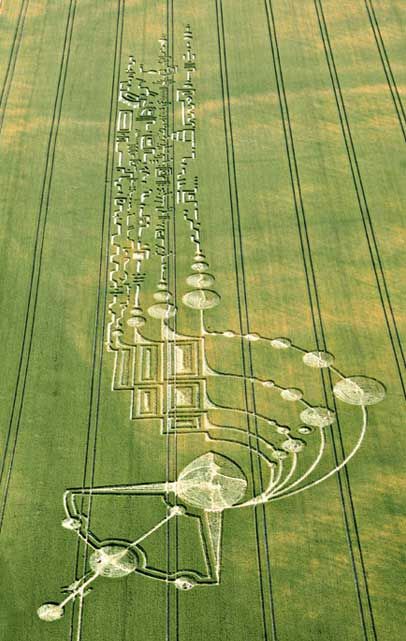The Milk Hill Crop Circle (2009)

Milk Hill in Wiltshire, UK, is one of the most famous locations for crop circles. Milk Hill is distinguished not only as the highest point in the county but also as a notable feature within the North Wessex Downs Area of Outstanding Natural Beauty. The hill reaches an elevation of 295 meters (968 feet), offering expansive views of the surrounding countryside, which is characterized by its rolling hills and agricultural lands.
The area around Milk Hill encompasses several hundred acres, with the hill itself is part of a larger rural and natural landscape that includes fields, paths, and natural wildlife habitats, making it a popular destination for walkers, hikers, and nature enthusiasts.
Here are some of the notable crop circles that have appeared there over the years:
- 1990 – The crop circle where Steve Alexander captured the footage of a mysterious metallic ball. This event is significant due to the visual documentation of an unexplained phenomenon associated with the formation of the crop circle.
- 1991 – Known for complex designs, this year brought more intricate and sophisticated patterns, contributing to Milk Hill’s reputation as a hotspot for crop circle formations.
- 2000 – This year witnessed the appearance of one of the most complex crop circles ever recorded, which consisted of hundreds of circles forming a massive spiral pattern. This formation, found on August 12, 2000, was comprised of 409 circles and stretched over 900 feet, making it one of the largest and most intricate designs.
- 2001 – Another remarkable formation appeared this year, known for its beauty and complexity. It featured a six-arm geometric pattern that included circles and intricate linear patterns, further mystifying both enthusiasts and researchers.
Intelligent design in the context of crop circles refers to the theory that some crop circles are created by an intelligent, non-human force. Crop circles are patterns that appear mysteriously overnight in fields, primarily of cereal crops, such as wheat or corn. These intricate patterns often appear as precise, complex geometric figures that can be visually stunning.
Theories of non-human intelligence offer various explanations for the origin of crop circles. One popular theory suggests that extraterrestrial beings create crop circles as a form of communication or as markers of their presence on Earth. Proponents of this theory point to the precision and complexity of the patterns, which they argue could not be replicated by human means alone. This theory is sometimes supported by reports of unexplained lights and UFO sightings in areas where crop circles later appear.
Another theory posits that beings from other dimensions or parallel universes could be responsible for these formations. This idea is rooted in speculative physics and suggests that crop circles could be physical manifestations of higher-dimensional energy influences or attempts at communication from beings in those dimensions.
Considering the hypothesis of intelligent design by non-human entities in crop circles, it points towards a fascinating possibility of communication or marking by otherworldly beings or unknown natural forces, enriching the mystery and allure surrounding these phenomena.
In July 1990, at Milk Hill in Wiltshire, UK, a significant event was captured on video by Steve Alexander, a prominent researcher in the field of crop circles. While filming a crop circle, Alexander noticed a small, glowing metallic ball in an adjacent field. He quickly turned his camera to record this anomaly. The object, which initially hovered and moved slowly across the field, suddenly accelerated, passing close by a tractor operated by Liam Beasant. Beasant, who later confirmed the sighting, described the object as completely unlike anything he had previously encountered.
The Milk Hill crop circles, with their recurring intricate designs, have not only cemented Wiltshire’s reputation as a focal point for these phenomena but also challenged the conventional understanding of their origins. Over the years, from the initial simple patterns to the staggering complexity of later formations, such as the 2000 spiral of 409 circles, these creations suggest more than mere human artistry. The theories suggesting intelligent non-human involvement—be it extraterrestrial or interdimensional—find support in the documented precision of the patterns and unusual activities, like the metallic ball captured by Steve Alexander in 1990. This enduring mystery serves as both a beacon for scientific curiosity and a canvas for the unknown, ensuring that Milk Hill remains a significant site in the study of crop circles. As each new pattern emerges, it invites us to ponder not just the ‘how’ but also the ‘why,’ further blurring the lines between the known and the unfathomable in our quest for answers.


